|
|
|
Sort Order |
|
|
|
Items / Page
|
|
|
|
|
|
|
| Srl | Item |
| 1 |
ID:
091869
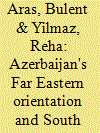

|
|
|
|
|
| Publication |
2009.
|
| Summary/Abstract |
This paper focuses on Azerbaijan's outreach toward East Asian countries and its relationship with South Korea. Despite their geographical distance from Azerbaijan, countries in the Far East, especially China, Japan, and South Korea, have demonstrated an interest in engagement and explored potential avenues of cooperation. Azerbaijan established support for its political priorities and for its stance on the Karabakh issue as prerequisites and confidence-building measures for potential investors. East Asian states easily fulfilled these two criteria, due to their geographical and ideological distance from the political dynamics of the Caucasus. South Korea showed a genuine concern for Azerbaijan's national interests and problems and played a key role in its economic development. While South Korea was a latecomer, mutual political trust and fruitful economic relations were quickly established. The Azeri administration has entrusted South Korean public and private investors with many significant current and future projects in the oil- and non-oil-related fields. This paper concludes that these projects are indicators of the central role that South Korea will play in Azerbaijan's future.
|
|
|
|
|
|
|
|
|
|
|
|
|
|
|
|
| 2 |
ID:
139782
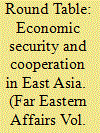

|
|
|
|
|
| Summary/Abstract |
This is a summary of the discussion that was conducted in the round-table format at the RAS Institute for Far Eastern Studies (the RAS IFES). The issues raised at the round table concerned the region's economic development, the rise of China, the reversal of U.S. policy toward it, and Russia's turnaround to face East. Nontraditional security and processes and factors affecting economic security in East Asia were among other issues discussed. Speakers at the round table looked from every angle at the potential and patterns to be used to achieve closer economic cooperation and assessed the possible limits of integration between the region's countries and leading world powers.
|
|
|
|
|
|
|
|
|
|
|
|
|
|
|
|
| 3 |
ID:
145880
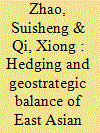

|
|
|
|
|
| Summary/Abstract |
While most East Asian countries have opted for a hedge strategy to preserve a maximum range of strategic options in response to the rise of China, some countries have engaged in geostrategic balance through collective bargaining and strategic alignments with the US and with each other. The divergent threat perceptions and complicated historical animosities among East Asian countries, however, have set a limitation on the geostrategic balance. Therefore, to bandwagon with China could be a realistic choice for many countries. Historically, the most successful rising powers have been those which attracted the greatest number of bandwagoners. China cannot rise successfully without winning the support of its Asian neighbors. The long term peace and stability in the region, therefore, depends not only on whether China’s neighbors can work together to balance China but also whether China can balance its relationships in its own backyard so that its neighbors find bandwagoning a positive choice.
|
|
|
|
|
|
|
|
|
|
|
|
|
|
|
|
| 4 |
ID:
128322
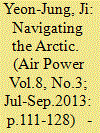

|
|
|
|
|
| Publication |
2013.
|
| Summary/Abstract |
For the next few decades, the Arctic will provide problems and prospects which may induce inevitable competition for the lion`s share among the stakeholders. While the arctic was perceived as an undiscovered area and a non-navigable ice cap in the past, recent environmental and scientific changes have brought to the fore the assets of the region. The current size of the ice cape has shrunk by more than 40 percent compared to its size in the late 1970s, which has disclosed an area of open water. The enlarged open water provides the opportunity to explore more economic benefits, and for larger marine and other military activities. The major stakeholders sharing the coastal line of the Arctic are eight states member of the Arctic Council: Canada, Denmark, Finland, Iceland, Norway, Russia, Sweden and the United States. Presently, these states are putting in their utmost efforts in to investigating and participating in exploring the Arctic, which will be the foundation of the legal claim for sovereignty.
|
|
|
|
|
|
|
|
|
|
|
|
|
|
|
|
| 5 |
ID:
078845
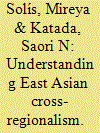

|
|
|
|
|
| Publication |
2007.
|
| Summary/Abstract |
A key feature of East Asian FTA diplomacy remains unacknowledged and, therefore, unaccounted for: the activism displayed in seeking preferential trading relations with countries outside the region. While European and North American countries have also pursued cross-regional trade agreements (CRTAs), East Asia is unique in pursuing extra-regional partnerships before consolidating the regional trade integration process. This framework article identifies the common patterns and fundamental factors behind the East Asian governments' moves towards establishing CRTAs. After laying out the conventional arguments-ranging from the extra-regional market dependence, the region's security arrangements, and economic and political motives behind East Asia's extra-regional interests-the article introduces the novel concept of "leverage." This notion highlights how cross-regional and intra-regional FTA initiatives are intimately linked: East Asian countries frequently choose an extra-regional FTA partner in order to break regional inertias that hinder integration, to win domestic battles, and to appropriate extra-regional negotiation modalities that they can use in their subsequent intra-regional FTA negotiations. The article concludes with a summary of the findings from the country cases, and the policy implications of East Asia's porous regionalism, with its heavy doses of cross-regional trade initiatives.
|
|
|
|
|
|
|
|
|
|
|
|
|
|
|
|
|
|
|
|
|